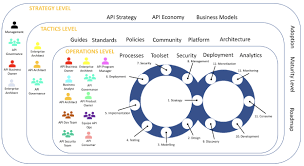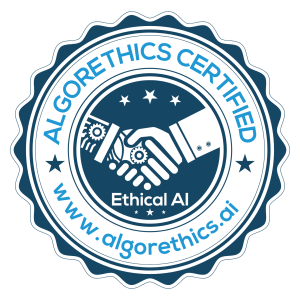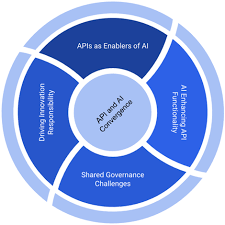In today’s interconnected digital world, the rapid evolution of technology has led organizations to simultaneously grapple with the complexity of managing API ecosystems and the transformative power of AI. While APIs enable seamless integration and data flow across systems, AI introduces unparalleled capabilities in decision-making, automation, and personalization. However, these innovations also bring unique challenges, from ethical concerns and regulatory compliance to system reliability and security.
This dual imperative calls for an integrated governance framework—one that aligns the technical, strategic, and ethical dimensions of both APIs and AI. By embracing such a framework, organizations can achieve digital excellence while fostering trust, innovation, and accountability.
The Convergence of API and AI Governance
Integrating API and AI governance is essential due to the growing interdependence of these technologies in modern digital ecosystems. Organizations are leveraging APIs and AI to drive innovation, streamline operations, and enhance customer experiences. However, the convergence of these technologies introduces unique opportunities and challenges that necessitate a unified governance approach.
- APIs as Enablers of AI
APIs are the primary mechanism through which AI capabilities are delivered across platforms, applications, and ecosystems. They provide:
Seamless Connectivity: APIs allow applications to interact with AI models hosted on different platforms, enabling functionalities like natural language processing (NLP), image recognition, and predictive analytics.
Scalability: APIs ensure that AI services can be scaled on demand, meeting the needs of diverse users and applications.
Interoperability: By standardizing communication between systems, APIs ensure that AI capabilities can be integrated with existing infrastructures, reducing development complexity. - AI Enhancing API Functionality
AI technologies enrich APIs by adding layers of intelligence to their core functions:
Dynamic Routing: AI can optimize how requests are processed and routed, improving API efficiency and reducing latency.
Enhanced Security: Machine learning algorithms can detect anomalous API usage patterns, proactively identifying potential threats.
Predictive Maintenance: AI-powered analytics can forecast system issues, ensuring APIs remain reliable and available.
Personalized Interactions: By leveraging user data, AI-enabled APIs can tailor responses and recommendations to individual users, improving engagement. - Shared Governance Challenges
Both APIs and AI require robust governance to address common challenges:
Data Dependency: APIs and AI both rely on high-quality data to function effectively. Governance must ensure data is accurate, secure, and free from bias.
Regulatory Compliance: The legal frameworks governing data use, privacy, and AI ethics are rapidly evolving. Governance must adapt to ensure compliance across both domains.
Accountability and Transparency: Users and stakeholders demand transparency about how systems operate. Integrated governance must enforce explainability for both API interactions and AI decisions.
Risk Mitigation: Both technologies carry risks, such as security vulnerabilities in APIs and ethical concerns in AI. Unified policies can address these issues holistically. - Driving Innovation Responsibly
A unified governance approach fosters innovation by:
Establishing clear boundaries for experimentation and deployment.
Encouraging cross-functional collaboration between both API and AI teams.
Providing frameworks for measuring the impact of new solutions while ensuring ethical considerations are upheld.
Thus, integrating API and AI governance is not merely a technical necessity but a strategic enabler. It ensures that organizations can leverage the synergy of these technologies to achieve their goals responsibly and effectively, paving the way for sustainable digital transformation.
The API Adoption Framework
Innovation is a critical driver for growth and transformation in today’s digital economy. However, navigating the complexity of large-scale initiatives—like API integration—requires a structured approach. The API Adoption Framework, as outlined in a previous article, exemplifies how such an approach can guide organizations through the complexities of implementing APIs while unlocking their transformative potential. This framework not only provides a roadmap for innovation but also demonstrates the broader advantages of applying a structured strategy to tackle intricate challenges.
At its core, the API Adoption Framework is built on three interconnected layers: strategic, tactical, and operational. Each layer addresses specific aspects of API adoption, ensuring alignment between an organization’s vision and its execution.
The strategic layer focuses on aligning API initiatives with business goals, ensuring that APIs contribute directly to measurable outcomes like efficiency, customer satisfaction, or revenue growth. By connecting innovation to these tangible results, organizations gain clarity on the purpose and value of their efforts. This layer also emphasizes understanding the API economy, monetization opportunities, and the role of APIs in fostering ecosystems, which are essential for organizations looking to scale and innovate.
The tactical layer delves into the operational and technical aspects, addressing issues like security, usability, and developer engagement. It ensures that APIs are designed and maintained with consistency and quality, providing a seamless experience for users and stakeholders. This layer also focuses on building a supportive developer community and leveraging analytics to refine performance and adoption. By establishing best practices and clear standards, the tactical layer simplifies complexity and fosters collaboration, which is vital for sustaining innovation.
Finally, the operational layer manages the lifecycle of APIs, from their creation to retirement. This includes establishing workflows, deploying the right tools, and defining roles and responsibilities. The operational focus ensures that APIs remain effective and aligned with evolving business needs while minimizing risks and inefficiencies.







